The Cambridge History of China. Vol. 06. Alien Regimes and Border States, 907-1368
Подождите немного. Документ загружается.

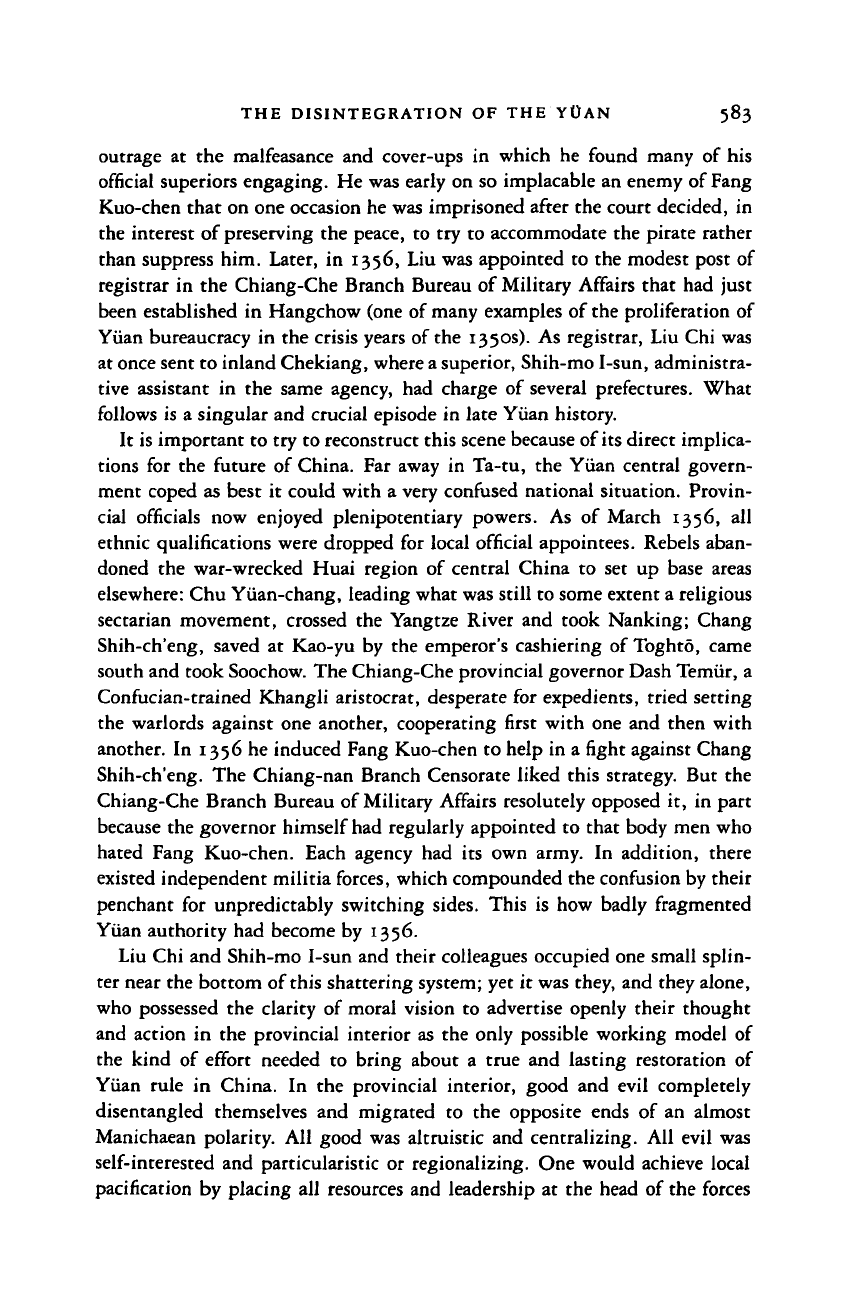
THE DISINTEGRATION OF THE YOAN 583
outrage at the malfeasance and cover-ups in which he found many of his
official superiors engaging. He was early on so implacable an enemy of Fang
Kuo-chen that on one occasion he was imprisoned after the court decided, in
the interest of preserving the peace, to try to accommodate the pirate rather
than suppress him. Later, in 1356, Liu was appointed to the modest post of
registrar in the Chiang-Che Branch Bureau of Military Affairs that had just
been established in Hangchow (one of many examples of the proliferation of
Yuan bureaucracy in the crisis years of the 1350s). As registrar, Liu Chi was
at once sent to inland Chekiang, where a superior, Shih-mo I-sun, administra-
tive assistant in the same agency, had charge of several prefectures. What
follows is a singular and crucial episode in late Yuan history.
It is important to try to reconstruct this scene because of its direct implica-
tions for the future of China. Far away in Ta-tu, the Yuan central govern-
ment coped as best it could with a very confused national situation. Provin-
cial officials now enjoyed plenipotentiary powers. As of March 1356, all
ethnic qualifications were dropped for local official appointees. Rebels aban-
doned the war-wrecked Huai region of central China to set up base areas
elsewhere: Chu Yuan-chang, leading what was still to some extent a religious
sectarian movement, crossed the Yangtze River and took Nanking; Chang
Shih-ch'eng, saved at Kao-yu by the emperor's cashiering of Toghto, came
south and took Soochow. The Chiang-Che provincial governor Dash Temiir, a
Confucian-trained Khangli aristocrat, desperate for expedients, tried setting
the warlords against one another, cooperating first with one and then with
another. In 1356 he induced Fang Kuo-chen to help in a fight against Chang
Shih-ch'eng. The Chiang-nan Branch Censorate liked this strategy. But the
Chiang-Che Branch Bureau of Military Affairs resolutely opposed it, in part
because the governor himself had regularly appointed to that body men who
hated Fang Kuo-chen. Each agency had its own army. In addition, there
existed independent militia forces, which compounded the confusion by their
penchant for unpredictably switching sides. This is how badly fragmented
Yuan authority had become by 1356.
Liu Chi and Shih-mo I-sun and their colleagues occupied one small splin-
ter near the bottom of this shattering system; yet it was they, and they alone,
who possessed the clarity of moral vision to advertise openly their thought
and action in the provincial interior as the only possible working model of
the kind of effort needed to bring about a true and lasting restoration of
Yuan rule in China. In the provincial interior, good and evil completely
disentangled themselves and migrated to the opposite ends of an almost
Manichaean polarity. All good was altruistic and centralizing. All evil was
self-interested and particularistic or regionalizing. One would achieve local
pacification by placing all resources and leadership at the head of the forces
Cambridge Histories Online © Cambridge University Press, 2008
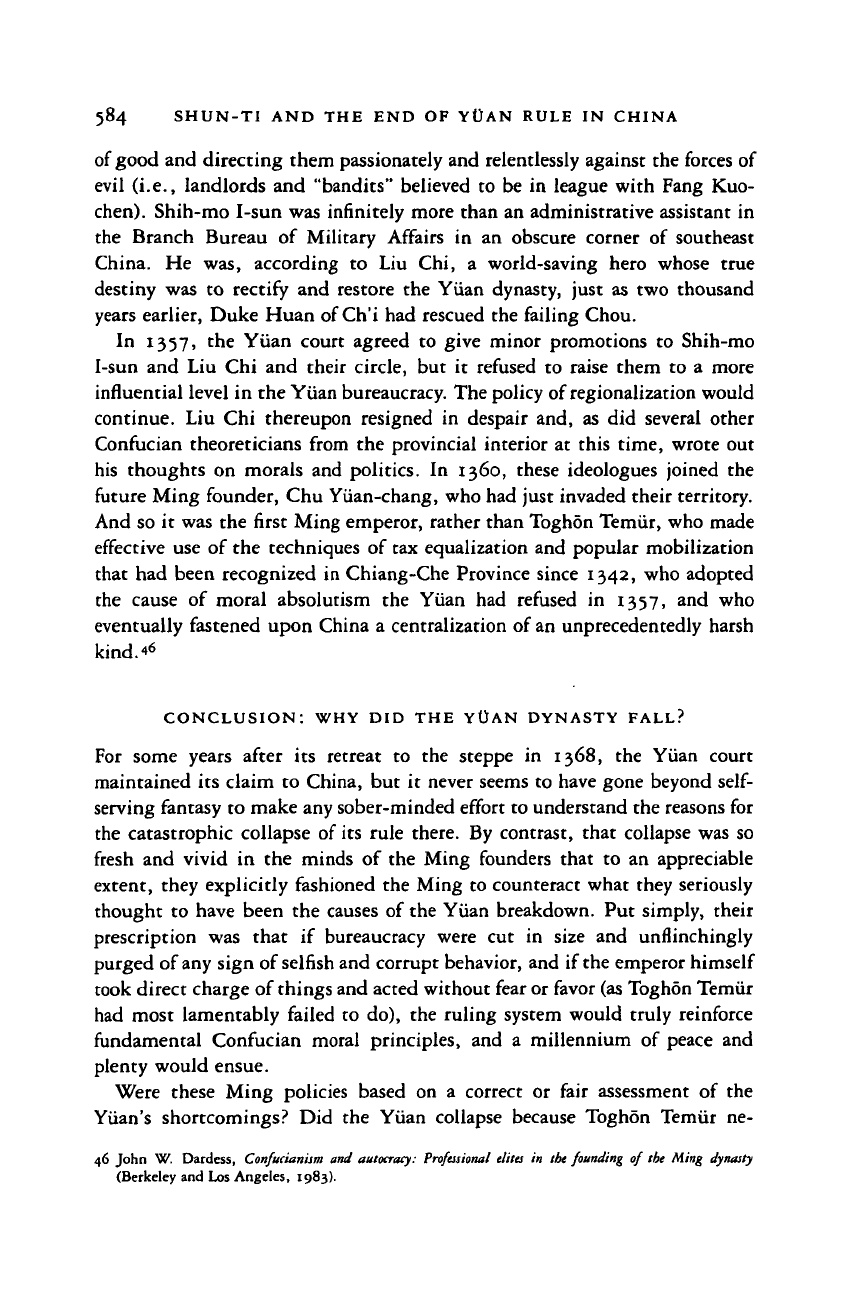
584 SHUN-TI AND THE END OF YUAN RULE IN CHINA
of good and directing them passionately and relentlessly against the forces of
evil (i.e., landlords
and
"bandits" believed
to be in
league with Fang Kuo-
chen).
Shih-mo I-sun was infinitely more than
an
administrative assistant
in
the Branch Bureau
of
Military Affairs
in an
obscure corner
of
southeast
China.
He
was,
according
to Liu
Chi,
a
world-saving hero whose true
destiny
was
to
rectify
and
restore
the
Yuan dynasty, just
as two
thousand
years earlier, Duke Huan of Ch'i had rescued the failing Chou.
In
1357, the
Yuan court agreed
to
give minor promotions
to
Shih-mo
I-sun
and Liu Chi and
their circle,
but
it
refused
to
raise them
to
a
more
influential level
in
the Yuan bureaucracy. The policy of regionalization would
continue.
Liu Chi
thereupon resigned
in
despair
and, as did
several other
Confucian theoreticians from
the
provincial interior
at
this time, wrote
out
his thoughts
on
morals
and
politics.
In
1360, these ideologues joined
the
future Ming founder, Chu Yuan-chang, who had just invaded their territory.
And so
it
was
the
first Ming emperor, rather than Toghon Temiir, who made
effective use
of
the techniques
of
tax equalization
and
popular mobilization
that
had
been recognized
in
Chiang-Che Province since 1342, who adopted
the cause
of
moral absolutism
the
Yuan
had
refused
in
1357, and who
eventually fastened upon China
a
centralization
of
an unprecedentedly harsh
kind.*
6
CONCLUSION: WHY DID THE YUAN DYNASTY FALL?
For some years after
its
retreat
to the
steppe
in
1368, the
Yuan court
maintained
its
claim
to
China,
but
it
never seems
to
have gone beyond
self-
serving fantasy
to
make any sober-minded effort to understand the reasons for
the catastrophic collapse
of
its rule there.
By
contrast, that collapse was
so
fresh
and
vivid
in
the
minds
of
the
Ming founders that
to
an
appreciable
extent, they explicitly fashioned
the
Ming to counteract what they seriously
thought
to
have been
the
causes
of
the Yuan breakdown.
Put
simply, their
prescription
was
that
if
bureaucracy were
cut in
size
and
unflinchingly
purged of
any
sign of selfish and corrupt behavior, and if
the
emperor himself
took direct charge of things and acted without fear or favor (as Toghon Temiir
had most lamentably failed
to
do),
the
ruling system would truly reinforce
fundamental Confucian moral principles,
and
a
millennium
of
peace
and
plenty would ensue.
Were these Ming policies based
on a
correct
or
fair assessment
of
the
Yiian's shortcomings?
Did the
Yuan collapse because Toghon Temiir
ne-
46 John
W.
Dardess, Confucianism
and
autocracy: Professional elites
in
the founding
of
the
Ming dynasty
(Berkeley
and
Los Angeles, 1983).
Cambridge Histories Online © Cambridge University Press, 2008
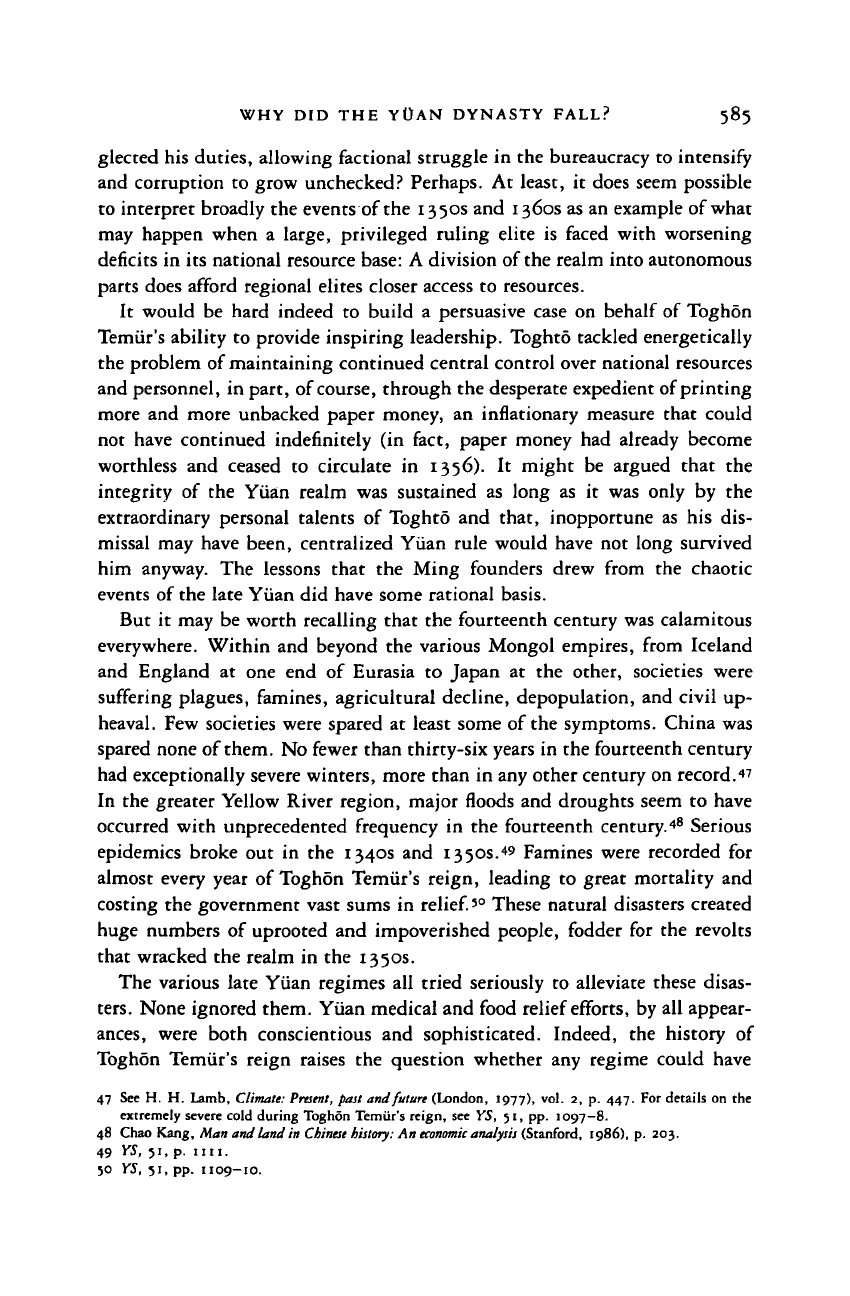
WHY DID THE YOAN DYNASTY FALL? 585
glected his duties, allowing factional struggle in the bureaucracy to intensify
and corruption to grow unchecked? Perhaps. At least, it does seem possible
to interpret broadly the events of the 1350s and 1360s as an example of what
may happen when a large, privileged ruling elite is faced with worsening
deficits in its national resource base: A division of the realm into autonomous
parts does afford regional elites closer access to resources.
It would be hard indeed to build a persuasive case on behalf of Toghon
Temiir's ability to provide inspiring leadership. Toghto tackled energetically
the problem of maintaining continued central control over national resources
and personnel, in part, of
course,
through the desperate expedient of printing
more and more unbacked paper money, an inflationary measure that could
not have continued indefinitely (in fact, paper money had already become
worthless and ceased to circulate in 1356). It might be argued that the
integrity of the Yuan realm was sustained as long as it was only by the
extraordinary personal talents of Toghto and that, inopportune as his dis-
missal may have been, centralized Yuan rule would have not long survived
him anyway. The lessons that the Ming founders drew from the chaotic
events of the late Yuan did have some rational basis.
But it may be worth recalling that the fourteenth century was calamitous
everywhere. Within and beyond the various Mongol empires, from Iceland
and England at one end of Eurasia to Japan at the other, societies were
suffering plagues, famines, agricultural decline, depopulation, and civil up-
heaval. Few societies were spared at least some of the symptoms. China was
spared none of them. No fewer than thirty-six years in the fourteenth century
had exceptionally severe winters, more than in any other century on record.
47
In the greater Yellow River region, major floods and droughts seem to have
occurred with unprecedented frequency in the fourteenth century.
48
Serious
epidemics broke out in the 1340s and 1350s.
49
Famines were recorded for
almost every year of Toghon Temiir's reign, leading to great mortality and
costing the government vast sums in
relief.'
0
These natural disasters created
huge numbers of uprooted and impoverished people, fodder for the revolts
that wracked the realm in the 1350s.
The various late Yuan regimes all tried seriously to alleviate these disas-
ters.
None ignored them. Yuan medical and food relief efforts, by all appear-
ances,
were both conscientious and sophisticated. Indeed, the history of
Toghon Temiir's reign raises the question whether any regime could have
47
See H. H.
Lamb, Climate:
Present,
past and future (London, 1977),
vol. 2, p. 447. For
details
on the
extremely severe cold during Toghon Temiir's reign,
see YS, 51, pp.
1097-8.
48
Chao Kang, Man and land in
Chinese
history: An
economic
analysis (Stanford, 1986), p. 203.
49 YS, 51, p. 1111.
50 YS, 51, pp. 1109-10.
Cambridge Histories Online © Cambridge University Press, 2008
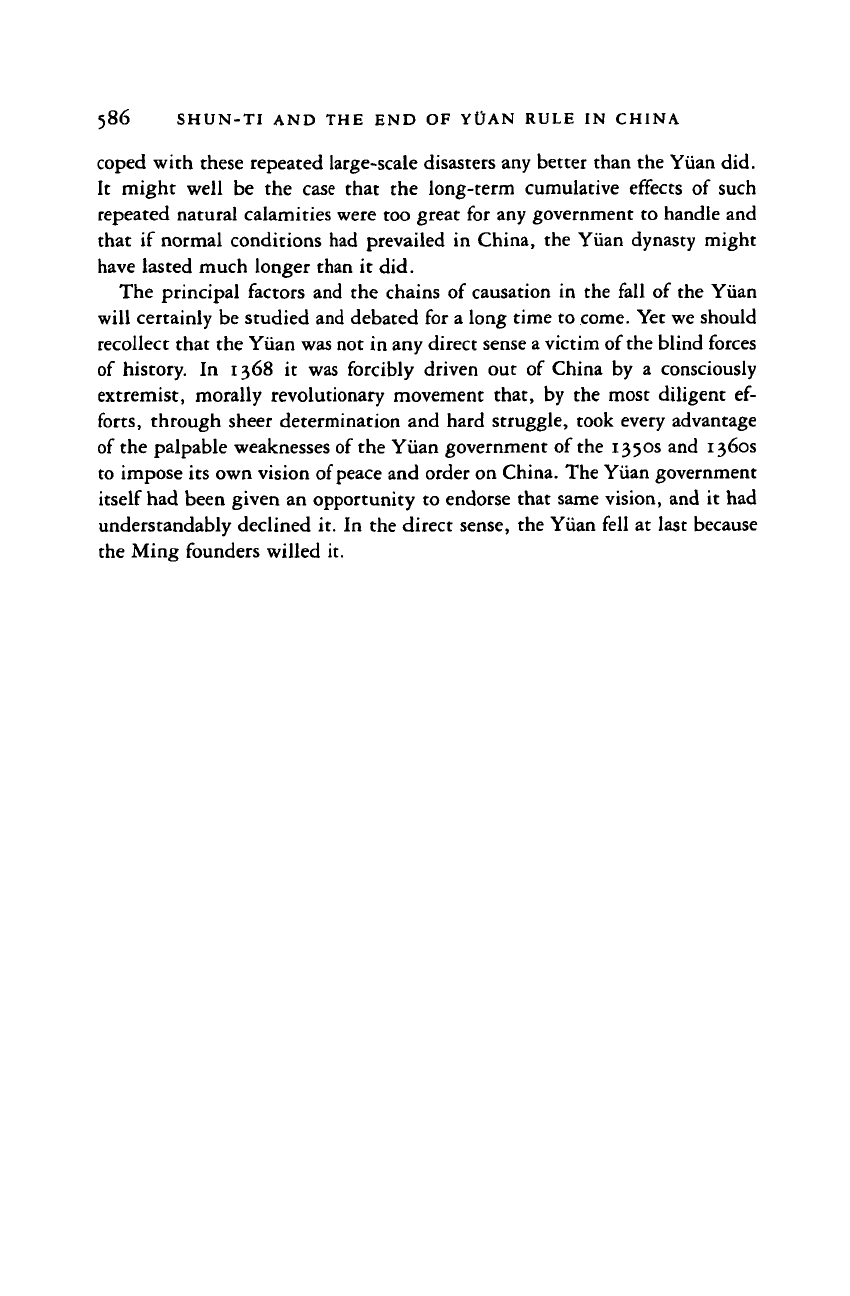
586 SHUN-TI AND THE END OF Y0AN RULE IN CHINA
coped with these repeated large-scale disasters any better than the Yuan did.
It might well be the case that the long-term cumulative effects of such
repeated natural calamities were too great for any government to handle and
that if normal conditions had prevailed in China, the Yuan dynasty might
have lasted much longer than it did.
The principal factors and the chains of causation in the fall of the Yuan
will certainly be studied and debated for a long time to come. Yet we should
recollect that the Yuan was not in any direct sense
a
victim of the blind forces
of history. In 1368 it was forcibly driven out of China by a consciously
extremist, morally revolutionary movement that, by the most diligent ef-
forts,
through sheer determination and hard struggle, took every advantage
of the palpable weaknesses of the Yuan government of the 1350s and 1360s
to impose its own vision of peace and order on China. The Yuan government
itself had been given an opportunity to endorse that same vision, and it had
understandably declined it. In the direct sense, the Yuan fell at last because
the Ming founders willed it.
Cambridge Histories Online © Cambridge University Press, 2008
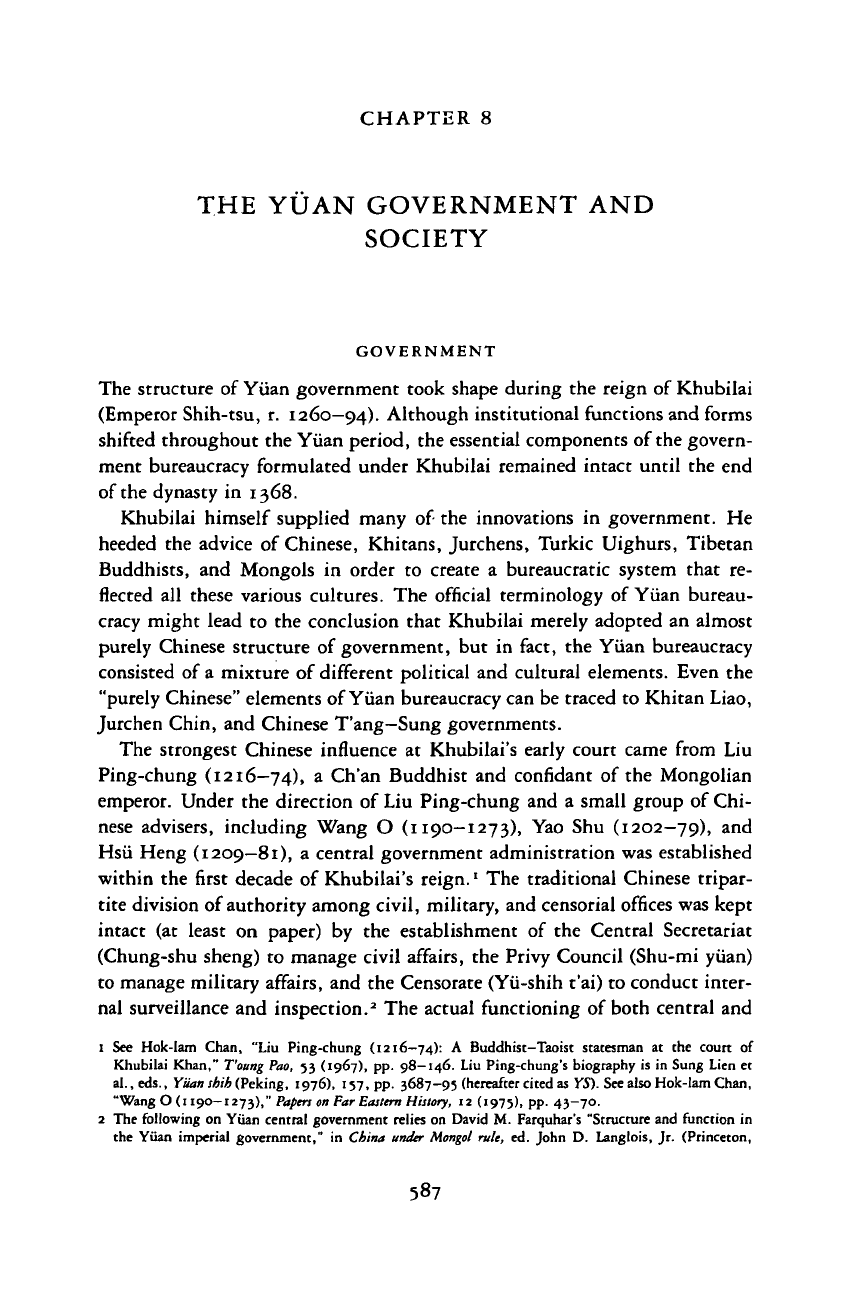
CHAPTER
8
THE YUAN GOVERNMENT AND
SOCIETY
GOVERNMENT
The structure of Yuan government took shape during the reign of Khubilai
(Emperor Shih-tsu, r. 1260—94). Although institutional functions and forms
shifted throughout the Yuan period, the essential components of the govern-
ment bureaucracy formulated under Khubilai remained intact until the end
of the dynasty in 1368.
Khubilai himself supplied many of the innovations in government. He
heeded the advice of Chinese, Khitans, Jurchens, Turkic Uighurs, Tibetan
Buddhists, and Mongols in order to create a bureaucratic system that re-
flected all these various cultures. The official terminology of Yuan bureau-
cracy might lead to the conclusion that Khubilai merely adopted an almost
purely Chinese structure of government, but in fact, the Yuan bureaucracy
consisted of a mixture of different political and cultural elements. Even the
"purely Chinese" elements of Yuan bureaucracy can be traced to Khitan Liao,
Jurchen Chin, and Chinese T'ang-Sung governments.
The strongest Chinese influence at Khubilai's early court came from Liu
Ping-chung (1216—74),
a
Ch'an Buddhist and confidant of the Mongolian
emperor. Under the direction of Liu Ping-chung and a small group of Chi-
nese advisers, including Wang O (1190-1273), Yao Shu (1202-79), and
Hsu Heng (1209-81), a central government administration was established
within the first decade of Khubilai's reign.' The traditional Chinese tripar-
tite division of authority among civil, military, and censorial offices was kept
intact (at least on paper) by the establishment of the Central Secretariat
(Chung-shu sheng) to manage civil affairs, the Privy Council (Shu-mi yuan)
to manage military affairs, and the Censorate (Yii-shih t'ai) to conduct inter-
nal surveillance and inspection.
2
The actual functioning of both central and
1 See Hok-Iam Chan, "Liu Ping-chung (1216-74): A Buddhist-Taoist statesman at the court of
Khubilai Khan,"
T'ouag
Pao, 53 (1967), pp. 98—146. Liu Ping-chung's biography is in Sung Lien et
al., eds., Yuan shih (Peking, 1976), 157, pp. 3687-95 (hereafter cited as YS). See also Hok-lam Chan,
"Wang O (1190-1273),"
Papers
on Far
Eastern
History, 12 (1975), pp. 43-70.
2 The following on Yuan central government relies on David M. Farquhar's "Structure and function in
the Yuan imperial government," in China under Mongol rule, ed. John D. Langlois, Jr. (Princeton,
587
Cambridge Histories Online © Cambridge University Press, 2008

588 THE YUAN GOVERNMENT AND SOCIETY
local government agencies reveals a great deal of overlap between civil and
military jurisdictions. Such overlap, for which the Mongols were much
criticized by Chinese scholar-officials, derived from the Mongols' traditional
reliance on military institutions and offices as the core of governance.
In spite of the Mongols' inclination to entrust power to the military,
a
self-
contained civilian bureaucracy was created in China. At the very top of the
Yuan civilian government, as it took shape under Khubilai, was the Central
Secretariat, first established under Ogodei (T'ai-tsung) in 1231 but, as with
most Yuan institutions, clearly defined only under Khubilai. The Central
Secretariat was the nerve center of
the
entire civilian bureaucracy. Most other
agencies in the Yuan structure of communication and control were ultimately
responsible to it. All memorials to the emperor, with the exception of those
written by high-ranking military and censorial officials, for example, passed
through the Central Secretariat. In turn, that office was empowered to make
recommendations, draft regulations, and make responses subject to imperial
approval. In addition to its role as communication center, the Central Secre-
tariat controlled official appointments to virtually all civilian offices in the
empire. However, appointments to the military, the Censorate, the Bureau of
Imperial Etiquette (Hsiian-hui yuan), and the Bureau of Buddhist and Ti-
betan Affairs (Hsiian-cheng yuan), and to certain offices in the hereditary
appanages were handled through their own channels.
At various times in the Yuan, a Secretariat of State Affairs (Shang-shu
sheng) was established, only to be abolished again. The Yuan, however,
never employed all three of
the
traditional three secretariats (or three depart-
ments,
san-sheng)
that had existed in T'ang times, that is, the Shang-shu
sheng, the Chung-shu sheng, and the Men-hsia sheng (Chancellery).
3
In its
reliance on only one such central government secretariat rather than on three,
the Yuan most resembled the Jurchen Chin dynasty, which in 1156 had
abolished two of its three secretariats, leaving only the Secretariat of State
Affairs, to which the six ministries were subordinate in Chin times.
It is doubtful whether this reliance on one rather than three secretariats
signified a centralization of government in Yuan times. Many other factors
conspired against centralization: notably, the tendency of the military bureau-
cracy to encroach on the civilian sphere, the existence of semi-independent
appanages outside regular government control, and the wide latitude taken
by regional and local officials despite the pyramidal structure of communica-
tion and control.
1981),
pp. 25—55; P
au
'
Ratchnevsky,
Un
code
da
Yuan,
vol. i
(Paris,
1937);
and the
"Monograph
on
officials"
(Pai
kuan
cbih), in YS,
chaps.
85-92.
3 YS, 85, p. 2121. See
Charles
O.
Hucker,
A
dictionary
of
official titles
in
imperial China
(Stanford,
1985),
pp. 28-31, 40-4, 55-7.
Cambridge Histories Online © Cambridge University Press, 2008
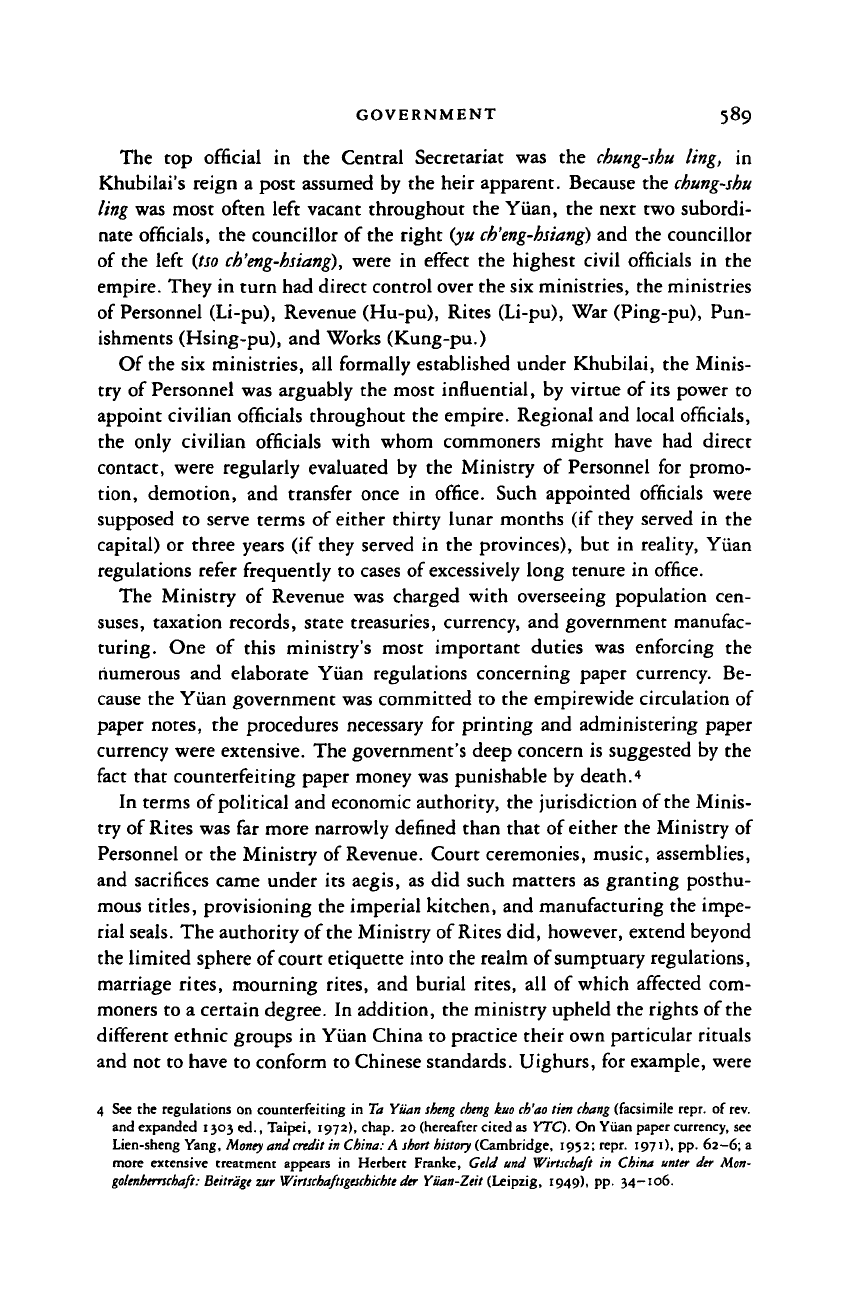
GOVERNMENT 589
The top official in the Central Secretariat was the chung-shu ling, in
Khubilai's reign a post assumed by the heir apparent. Because the
chung-shu
ling was most often left vacant throughout the Yuan, the next two subordi-
nate officials, the councillor of the right (yu
ch'eng-hsiang)
and the councillor
of the left (tso
ch'eng-hsiang),
were in effect the highest civil officials in the
empire. They in turn had direct control over the six ministries, the ministries
of Personnel (Li-pu), Revenue (Hu-pu), Rites (Li-pu), War (Ping-pu), Pun-
ishments (Hsing-pu), and Works (Kung-pu.)
Of the six ministries, all formally established under Khubilai, the Minis-
try of Personnel was arguably the most influential, by virtue of its power to
appoint civilian officials throughout the empire. Regional and local officials,
the only civilian officials with whom commoners might have had direct
contact, were regularly evaluated by the Ministry of Personnel for promo-
tion, demotion, and transfer once in office. Such appointed officials were
supposed to serve terms of either thirty lunar months (if they served in the
capital) or three years (if they served in the provinces), but in reality, Yiian
regulations refer frequently to cases of excessively long tenure in office.
The Ministry of Revenue was charged with overseeing population cen-
suses,
taxation records, state treasuries, currency, and government manufac-
turing. One of this ministry's most important duties was enforcing the
numerous and elaborate Yiian regulations concerning paper currency. Be-
cause the Yiian government was committed to the empirewide circulation of
paper notes, the procedures necessary for printing and administering paper
currency were extensive. The government's deep concern is suggested by the
fact that counterfeiting paper money was punishable by death.
4
In terms of political and economic authority, the jurisdiction of the Minis-
try of Rites was far more narrowly defined than that of either the Ministry of
Personnel or the Ministry of Revenue. Court ceremonies, music, assemblies,
and sacrifices came under its aegis, as did such matters as granting posthu-
mous titles, provisioning the imperial kitchen, and manufacturing the impe-
rial seals. The authority of the Ministry of Rites did, however, extend beyond
the limited sphere of court etiquette into the realm of sumptuary regulations,
marriage rites, mourning rites, and burial rites, all of which affected com-
moners to a certain degree. In addition, the ministry upheld the rights of the
different ethnic groups in Yiian China to practice their own particular rituals
and not to have to conform to Chinese standards. Uighurs, for example, were
4 See the regulations on counterfeiting in Ta Yiian
sheng cheng
kuo
ch'ao
tien
chang
(facsimile repr. of rev.
and expanded 1303 ed., Taipei, 1972), chap. 20 (hereafter cited as YTC). On Yuan paper currency, see
Lien-sheng Yang,
Money
and
credit
in China: A short
history
(Cambridge, 1952; repr. 1971), pp. 62—6; a
more extensive treatment appears in Herbert Franke, Geld und Wirtschaft in China unter der Mon-
golenherrschaft:
Beitrage zur
Wirtschaftsgeschichte
der Yiiati-Zeit (Leipzig, 1949), pp. 34—106.
Cambridge Histories Online © Cambridge University Press, 2008
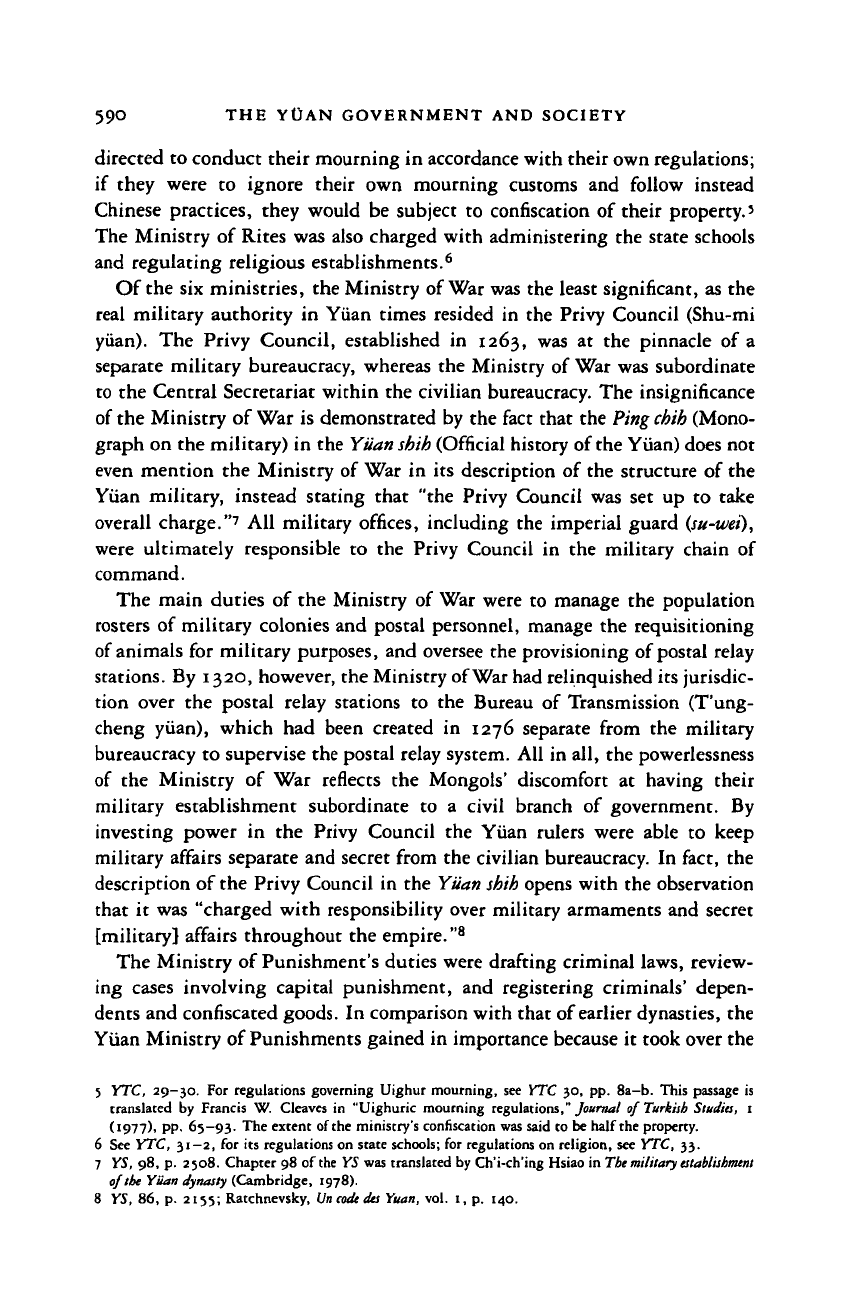
590 THE YOAN GOVERNMENT AND SOCIETY
directed to conduct their mourning in accordance with their own regulations;
if they were to ignore their own mourning customs and follow instead
Chinese practices, they would be subject to confiscation of their property.
5
The Ministry of Rites was also charged with administering the state schools
and regulating religious establishments.
6
Of the six ministries, the Ministry of War was the least significant, as the
real military authority in Yuan times resided in the Privy Council (Shu-mi
yuan).
The Privy Council, established in 1263, was at the pinnacle of a
separate military bureaucracy, whereas the Ministry of War was subordinate
to the Central Secretariat within the civilian bureaucracy. The insignificance
of the Ministry of War is demonstrated by the fact that the
Ping chih
(Mono-
graph on the military) in the
Yuan shih
(Official history of
the
Yuan) does not
even mention the Ministry of War in its description of the structure of the
Yuan military, instead stating that "the Privy Council was set up to take
overall charge."
7
All military offices, including the imperial guard
(su-wei),
were ultimately responsible to the Privy Council in the military chain of
command.
The main duties of the Ministry of War were to manage the population
rosters of military colonies and postal personnel, manage the requisitioning
of animals for military purposes, and oversee the provisioning of postal relay
stations. By 1320, however, the Ministry of War had relinquished its jurisdic-
tion over the postal relay stations to the Bureau of Transmission (T'ung-
cheng yuan), which had been created in 1276 separate from the military
bureaucracy to supervise the postal relay system. All in all, the powerlessness
of the Ministry of War reflects the Mongols' discomfort at having their
military establishment subordinate to a civil branch of government. By
investing power in the Privy Council the Yuan rulers were able to keep
military affairs separate and secret from the civilian bureaucracy. In fact, the
description of the Privy Council in the
Yuan shih
opens with the observation
that it was "charged with responsibility over military armaments and secret
[military] affairs throughout the empire."
8
The Ministry of Punishment's duties were drafting criminal laws, review-
ing cases involving capital punishment, and registering criminals' depen-
dents and confiscated goods. In comparison with that of earlier dynasties, the
Yuan Ministry of Punishments gained in importance because it took over the
5 YTC, 29-30. For regulations governing Uighur mourning, see YTC 30, pp. 8a-b. This passage is
translated by Francis W. Cleaves in "Uighuric mourning regulations," Journal of Turkish Studies, 1
(1977),
pp. 65—93. Th
e
extent of the ministry's confiscation was said to be half the property.
6 See YTC, 31—2, for its regulations on state schools; for regulations on religion, see YTC, 33.
7 YS, 98, p. 2508. Chapter 98 of the YS was translated by Ch'i-ch'ing Hsiao in The military
establishment
of the Yuan dynasty (Cambridge, 1978).
8 YS, 86, p. 2155; Ratchnevsky, Vn
code
da Yuan, vol. 1, p. 140.
Cambridge Histories Online © Cambridge University Press, 2008
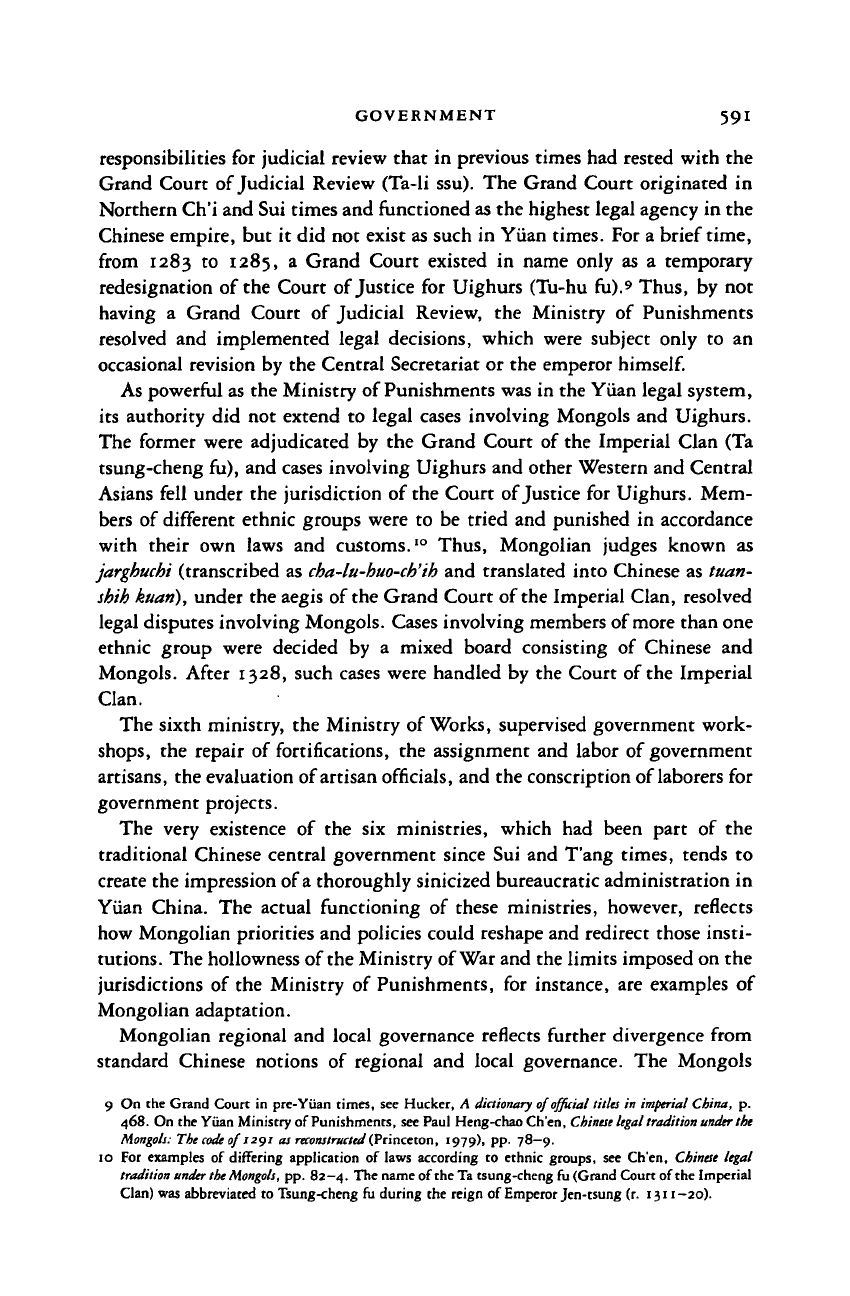
GOVERNMENT 591
responsibilities for judicial review that in previous times had rested with the
Grand Court of Judicial Review (Ta-li ssu). The Grand Court originated in
Northern Ch'i and Sui times and functioned as the highest legal agency in the
Chinese empire, but it did not exist as such in Yuan times. For a brief time,
from 1283 to 1285, a Grand Court existed in name only as a temporary
redesignation of the Court of Justice for Uighurs (Tu-hu fu).
9
Thus, by not
having a Grand Court of Judicial Review, the Ministry of Punishments
resolved and implemented legal decisions, which were subject only to an
occasional revision by the Central Secretariat or the emperor
himself.
As powerful as the Ministry of Punishments was in the Yiian legal system,
its authority did not extend to legal cases involving Mongols and Uighurs.
The former were adjudicated by the Grand Court of the Imperial Clan (Ta
tsung-cheng fu), and cases involving Uighurs and other Western and Central
Asians fell under the jurisdiction of the Court of Justice for Uighurs. Mem-
bers of different ethnic groups were to be tried and punished in accordance
with their own laws and customs.
10
Thus, Mongolian judges known as
jarghucbi (transcribed as cha-lu-huo-ch'ih and translated into Chinese as tuan-
shih kuari), under the aegis of the Grand Court of the Imperial Clan, resolved
legal disputes involving Mongols. Cases involving members of more than one
ethnic group were decided by a mixed board consisting of Chinese and
Mongols. After 1328, such cases were handled by the Court of the Imperial
Clan.
The sixth ministry, the Ministry of Works, supervised government work-
shops,
the repair of fortifications, the assignment and labor of government
artisans, the evaluation of artisan officials, and the conscription of laborers for
government projects.
The very existence of the six ministries, which had been part of the
traditional Chinese central government since Sui and T'ang times, tends to
create the impression of a thoroughly sinicized bureaucratic administration in
Yiian China. The actual functioning of these ministries, however, reflects
how Mongolian priorities and policies could reshape and redirect those insti-
tutions. The hollowness of the Ministry of War and the limits imposed on the
jurisdictions of the Ministry of Punishments, for instance, are examples of
Mongolian adaptation.
Mongolian regional and local governance reflects further divergence from
standard Chinese notions of regional and local governance. The Mongols
9 On the Grand Court in pre-Yiian times, see Hucker, A
dictionary
of
official titles
in
imperial
China,
p.
468.
On the Yiian Ministry of Punishments, see Paul Heng-chao Ch'en,
Chinese legal tradition under the
Mongols: The
code
of 1291 as
reconstructed
(Princeton, 1979), pp. 78—9.
10 For examples of differing application of laws according to ethnic groups, see Ch'en,
Chinese legal
tradition under the
Mongols,
pp. 82—4. The name of the Ta tsung-cheng fu (Grand Court of the Imperial
Clan) was abbreviated to Tsung-cheng fu during the reign of Emperor Jen-tsung (r.
1311
—20).
Cambridge Histories Online © Cambridge University Press, 2008
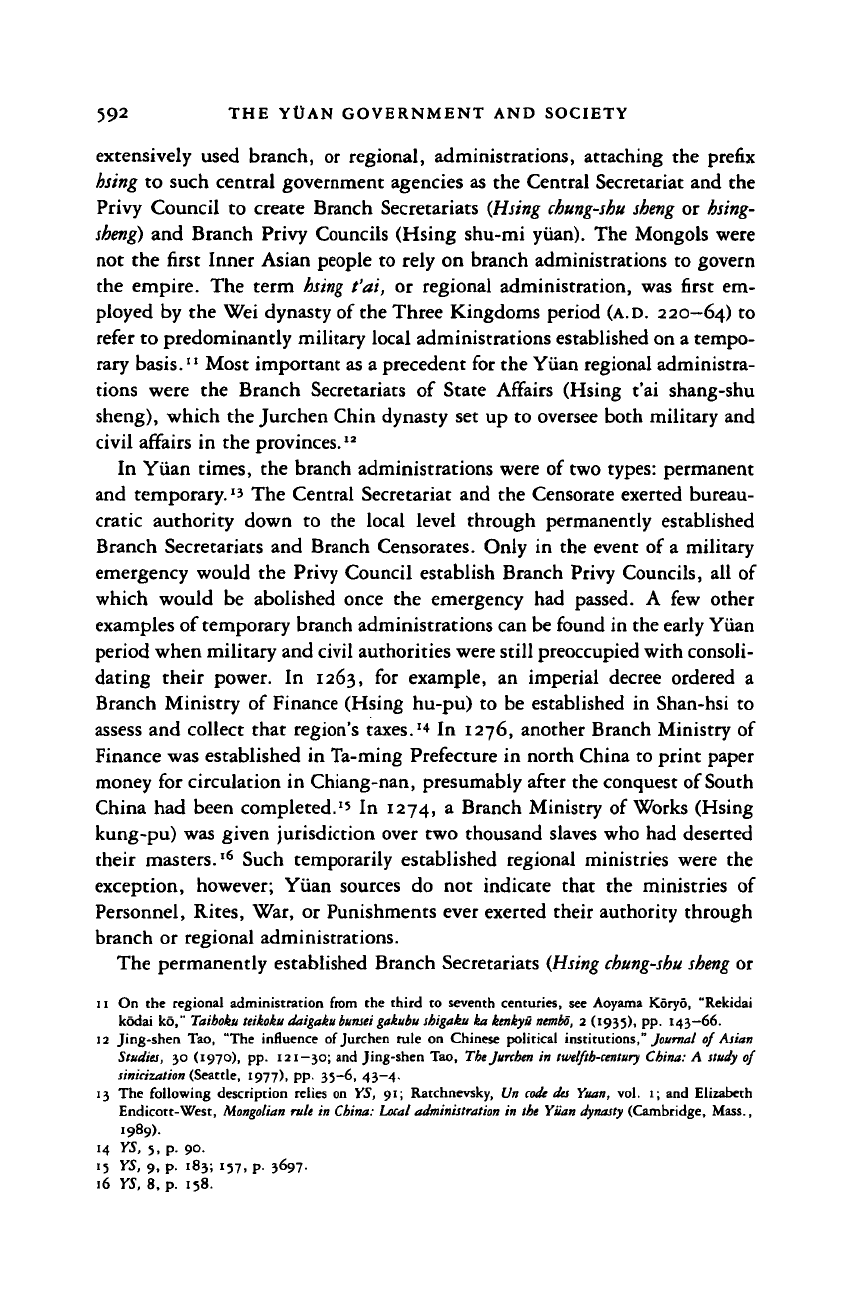
59
2
THE Yt)AN GOVERNMENT AND SOCIETY
extensively used branch, or regional, administrations, attaching the prefix
hsing
to such central government agencies as the Central Secretariat and the
Privy Council to create Branch Secretariats
(Hsing chung-shu sheng
or
hsing-
sheng)
and Branch Privy Councils (Hsing shu-mi yuan). The Mongols were
not the first Inner Asian people to rely on branch administrations to govern
the empire. The term
hsing
t'ai, or regional administration, was first em-
ployed by the Wei dynasty of the Three Kingdoms period
(A.D.
220-64)
to
refer to predominantly military local administrations established on a tempo-
rary basis." Most important as a precedent for the Yuan regional administra-
tions were the Branch Secretariats of State Affairs (Hsing t'ai shang-shu
sheng),
which the Jurchen Chin dynasty set up to oversee both military and
civil affairs in the provinces."
In Yuan times, the branch administrations were of two types: permanent
and temporary.'3 The Central Secretariat and the Censorate exerted bureau-
cratic authority down to the local level through permanently established
Branch Secretariats and Branch Censorates. Only in the event of a military
emergency would the Privy Council establish Branch Privy Councils, all of
which would be abolished once the emergency had passed. A few other
examples of temporary branch administrations can be found in the early Yuan
period when military and civil authorities were still preoccupied with consoli-
dating their power. In 1263, for example, an imperial decree ordered a
Branch Ministry of Finance (Hsing hu-pu) to be established in Shan-hsi to
assess and collect that region's taxes.
14
In 1276, another Branch Ministry of
Finance was established in Ta-ming Prefecture in north China to print paper
money for circulation in Chiang-nan, presumably after the conquest of South
China had been completed.
1
' In 1274,
a
Branch Ministry of Works (Hsing
kung-pu) was given jurisdiction over two thousand slaves who had deserted
their masters.
16
Such temporarily established regional ministries were the
exception, however; Yuan sources do not indicate that the ministries of
Personnel, Rites, War, or Punishments ever exerted their authority through
branch or regional administrations.
The permanently established Branch Secretariats
(Hsing chung-shu sheng
or
11 On the regional administration from the third to seventh centuries, see Aoyama Koryo, "Rekidai
kodai ko," Taiboku teikoku daigaku
bunsei
gakubu ihigaku ia keniyu
nembo,
2 (1933), pp. 143—66.
12 Jing-shen Tao, "The influence of Jurchen rule on Chinese political institutions," Journal of Asian
Studies, 30 (1970), pp. 121—30; and Jing-shen Tao,
The Jurchen
in
twelfth-century
China: A study of
sinidzation (Seattle, 1977), pp. 35-6, 43-4.
13 The following description relies on YS, 91; Ratchnevsky, (Jn
code
des Yuan, vol. 1; and Elizabeth
Endicott-West, Mongolian rule in China: Local administration in the Yiian dynasty (Cambridge, Mass.,
1989)-
14 YS, 5, p. 90.
15 YS, 9, p. 183; 157, p. 3697.
16 YS, 8, p. 158.
Cambridge Histories Online © Cambridge University Press, 2008
